A Week-by-Week Performance Nutrition Guide for Long-Course Training
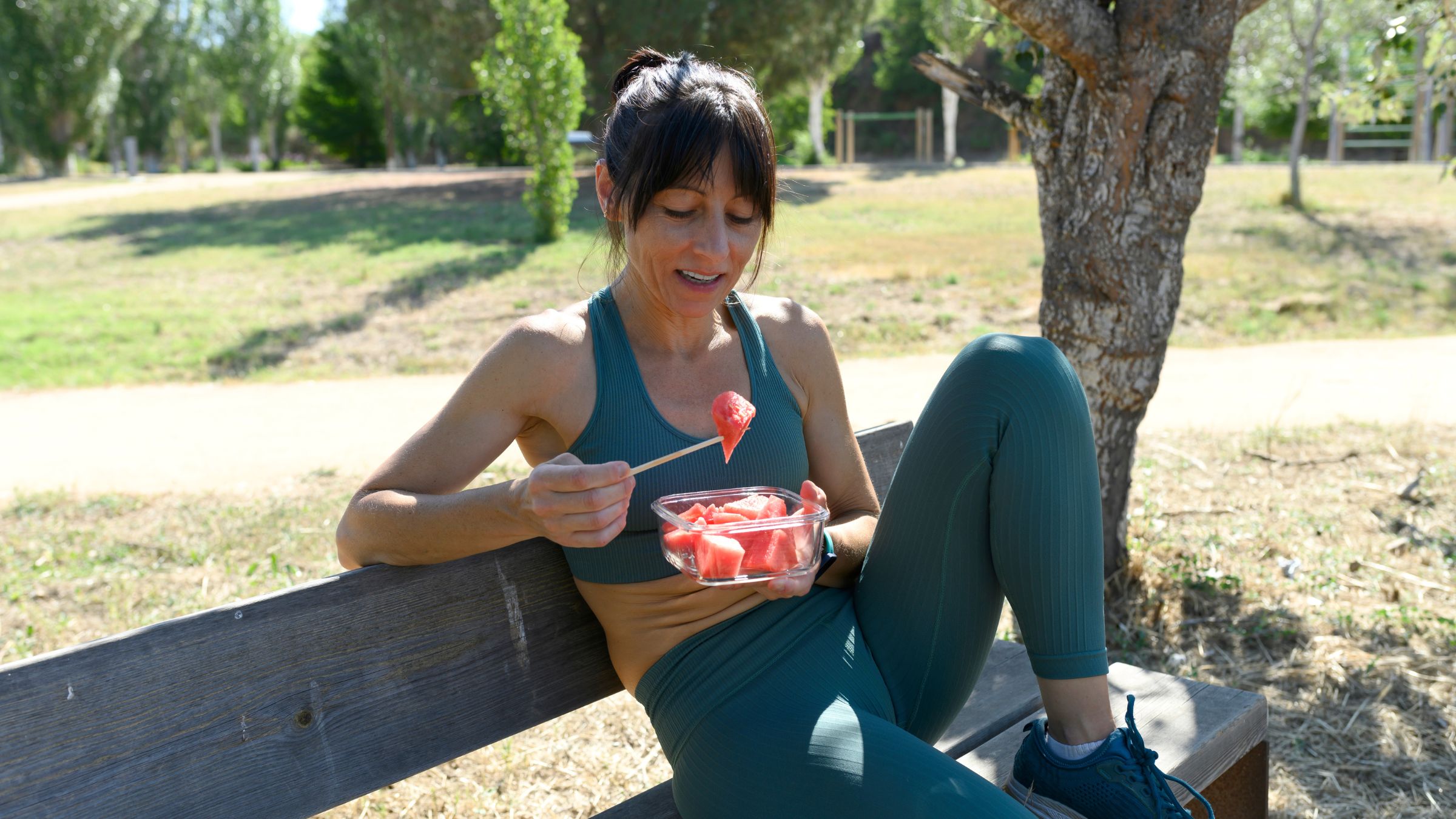
(Photo: Getty Images)
Table of Contents
When it comes to putting your nutrition plan together for a long-course race like a half or full iron-distance event, there are many factors to consider. It is not an easy task, and this is often why so many athletes are confused and frustrated by the process. But when it comes to fueling for long-course training, you don’t have to reinvent the wheel. Following a general framework of eating for triathlon training can help to unravel this difficult topic and establish principles that will allow you to fuel well. The key is to eat the right foods at the right time in your training.
Nutrition and appropriate fueling is so important for endurance athletes (and triathletes in particular) because of the impact food can have on your health and performance. Improved recovery, reduced muscle soreness, the ability to build muscle, a boost in training performance – all of this is well-documented in the literature as being heavily influenced by correct fueling.
Appropriate fueling will also contribute to better overall health. Eating well is associated with improved immune function and subsequent reductions in sickness during periods of increased training. The impact that correct fueling will have on bone mass and its maintenance also cannot be underplayed, especially when training for a long-course event. Low Energy Availability (LEA) and subsequent Relative Energy Deficiency in Sport (RED-S) are a consequence of getting performance nutrition wrong and are wholeheartedly avoidable when correct planning occurs.
The final benefit of correct fueling can be the improvement in substrate (fuel) utilization that can ultimately assist with improvements in body composition, health markers and race performance – this is in reference to both fat and carbohydrates and using them appropriately when the work requires it.
In the nutrition guidelines below, 12 weeks (mesocycle in a year) are broken down into specific blocks of “micro-cycles” that are aimed at achieving specific purposes for your training. In this particular framework, that looks like this:
- Week 0: Getting your house in order
- Weeks 1- 6: Improved body composition and weight loss
- Weeks 5-8: Understanding performance parameters centered around hydration and carbohydrate capacity testing
- Weeks 9-12: Refinement of the race plan, fueling and hydration.
Throughout these “micro-cycles,” there is a focus on daily nutrition to ensure correct fueling for health and performance. I believe it is important for the athlete to consider the purpose of their training and what they are attempting to achieve, as this will certainly dictate caloric intake and ultimately performance throughout the week. When an athlete is in a purposeful period of weight loss, it is not expected that the athlete is hitting their top numbers; conversely, when in a period of expected performance, do not expect to have a large degree of weight loss.
RELATED: How to Trim Weight While Still Crushing Training
Nutrition Guidelines for Long-Course Triathlon Training
Week 0: Getting the house in order
Before you start, it’s good to prepare for and ease into the next 12 weeks. By establishing baselines and getting the “house” in order, you will be in the best position to succeed in the task ahead. When discussing baselines, there are a number of tests and markers that can be implemented. Some of these are in relation to body composition and weight, some are in relation to assessing your general health and others are more directed to high performance. This week also presents the opportunity to prepare for the weeks ahead by restocking the pantry, fridge and freezer with required food types and throwing out all the unnecessary items that will sabotage your efforts to have the best race of your life.
Scenario 1: Male, 48 years old
A 48-year-old male who eats everything he wishes and does not have any known intolerances or allergies. He has a body weight of 189.2lbs/86kg, body composition of 26% body fat, Fat Mass Index (FMI) of 7.1kg/m2, visceral adipose tissue (VAT) 90cm2 and a Bone Mineral Density (BMD) 0.5 T-score. Based on this, he is aiming to lose approximately 8.8lbs/4kgs to 11lbs/5kgs of fat mass (ideal) in the next 12 weeks and improve his overall health through a reduction in visceral and subcutaneous fat. His BMD is excellent. He is starting his training with nine hours of training per week.
Macronutrients
Protein
| Protein | 190g/day (760kcal/day) |
This is calculated as 2.2g/kg body weight. Breaking this up into 5-6 meals per day, he would be aiming for 30-40 grams of protein per meal, staying constant each day of the week to assist with the consistency of meals and portion sizes. The amount of protein will reduce in line with reductions in body mass/weight.
Fat
| Fat | 80g/day (720kcal/day) |
I will usually begin an athlete on 0.9g/kg body weight and adjust depending on reported energy and total calories required for the week. Using the above method for assigning fat to each meal, eat 4-5 meals that have foods that contain fat. This would be approximately 16-20 grams of fat per meal. The amount of fat that is recommended each week will need to be adjusted as training volume & intensity goes up in order to meet caloric requirements to fuel his training. This is a similar concept to carbohydrates. The amount of fat that would be provided to an athlete can also be determined by the intensity of training being provided by the coach. If predominantly lower intensities (zones 1-2), there is the possibility to increase fat intake and reduce carbohydrates in order to maintain caloric requirements while manipulating the macronutrient percentages per day.
Carbohydrates
| Carbohydrates | 215-450g/day (860-1790kcal/day) |
The remaining amount of calories required for fueling will be derived from foods that are sources of carbohydrates. As the goal is to lose body fat, the starting target will be 2.5g/kg body weight, excluding any fuel that is required to be consumed during sessions. This is a starting point and will be adjusted based on changes to training volume week on week, any reported issues with fatigue or inability to perform sessions and also general well-being questions related to sleep quality, mood and hunger. The higher prescribed amounts of carbohydrates would be to appropriately fuel and recover from sessions lasting at least 90 minutes combined with a higher intensity (ie zone 3). The amount will depend on total duration for the day and across the entire week.
Total calories to begin the program: 2340-3270 kcal/day
Scenario 2: Female, 56 years old
A 56-year-old female in peri-menopause. She is an omnivore, although recognizes her diet is not very good with a lot of processed & take-away meals being consumed daily. She has a body weight of 143lbs/65kg, body composition of 31% body fat, fat mass index (FMI) of 9.7kg/m2, visceral adipose tissue (VAT) 100cm2 and a bone mineral density (BMD) -0.5 T-score. Based on this, she is aiming to lose approximately 10lbs/4.5kgs to 15lbs/6.8kgs of fat mass (ideal) in the next 12 weeks and improve her overall health through a reduction in visceral and subcutaneous fat. Her BMD is not ideal, and her nutrition program should include a consistent intake of calcium and vitamin D, combined with a high protein intake and weight training as part of her training plan. She is starting her training with nine hours of training per week.
Macronutrients
Protein
| Protein | 160g/day (640kcal/day) |
She will start on a high protein intake of 160g/day. This is calculated as 2.5g/kg body weight. This mainly due to her age, peri-menopausal status and the fact she has lower-than-optimal bone mineral density. Breaking this up into 5-6 meals per day, he would be aiming for 25-35g of protein per meal. This amount will stay constant each day of the week to assist with her consistency of meals and portion sizes. The amount of protein will reduce in line with reductions in body mass/weight.
Fat
| Fat | 65g/day (585kcal/day) |
I will commence a female athlete on 1.0g/kg body weight and adjust depending on reported energy, total calories required for the week, training intensity and total training hours.I would be suggesting she eat four meals that have foods that contain fat. This would be approximately 15-17 grams of fat per meal. One of her extra meals in the day could be a pure protein meal such as a protein shake to reduce the fat intake in that particular mea yet allow her to hit her protein target. The amount of fat that is recommended each week will be adjusted as training volume & intensity goes up in order to meet caloric requirements to fuel her training.
Carbohydrates
| Carbohydrates | 160-325g/day (640-1300 kcal/day) |
Carbohydrate-containing foods will make up the remaining amount of energy required to fuel her week’s training. Due to her desire to lose body fat, her starting target will be 2.5g/kg body weight and this will exclude any foods of fuel that she is required to consume within training sessions. The amount of carbohydrates that could be recommended on a particular day will be driven by the intensity and the duration. This is a starting point and will be adjusted based on changes to training volume week on week, any reported issues with fatigue or inability to perform sessions and also general well-being questions related to sleep quality, mood and hunger.
Total calories to begin the program: 1865-2525 kcal/day
Weeks 1-6: Body composition focus
These weeks are designed to dial in your daily nutrition to help achieve a sustainable and achievable weight loss (around 0.5kg/1 lb per week is a healthy target). Tracking your daily intake of food at each meal and sticking to the plan provided is a key component to you achieving the purpose of improving body composition and losing weight during this phase.
It is important to note that losing fat or weight is not always necessary. It is advised you consult with a health care specialist who understands the needs of the long-course triathlete, along with your individual requirements, before determining you need to drop weight.If you are attempting to lose fat mass and drop some kilograms, it is also important to convey this to your coach. This is crucial, because you are then setting expectations for performance and can both accept that sometimes the output may be a little lower than what would be expected if you were fueled up to the eyeballs, primed and ready to go. During a period of weight loss, there is the requirement and need for you to be in a caloric deficit. This means that you will be consuming fewer calories than your expenditure through exercise and daily activity. It does not have to be huge, yet a deficit does need to exist.
Vegetables and fruits
As the focus is a reduction in body fat, the quality of food being consumed is of utmost importance. The caloric density of foods should be considered in order to provide optimal satiety. Utilizing whole foods and avoiding processed and ultra-processed foods should feature high on your shopping list. This usually starts with consuming large volumes of vegetables whilst also aiming to include at least two servings of fruit per day. An intake of five to six servings of vegetables per day for each athlete is recommended to contribute to their overall carbohydrate intake and achieve a daily intake of at least 30 grams of fiber.
Meats and fish
There should be a focus on eating lean cuts of protein including red meat, poultry, game and plenty of fish, small oily varieties coupled with larger oily fish and white-fleshed fish. Fat intake should consist of plenty of mono-unsaturated sources such as olive and avocado oil, nuts, and seeds combined with omega-3 oil intake through fish or supplementation. Both athletes would be encouraged to consume at least one to two sources of heme-iron per week, including red meat, liver or other sources of offal. If this is unachievable, then the recommendation would be to liaise with a doctor to discuss the role of iron supplementation to support their training. This should be monitored through a repeated blood draw in ten to twelve weeks after supplementation commences.
RELATED: Should You Be Pumping More Iron into Your Diet?
Fats
It is also expected that a moderate amount of fat will be consumed through sources of protein and thus, huge amounts of additional fat in the form of dressings and toppings on meals are often not required and should be considered thoughtfully before adding them. A concerted effort to remove vegetable and coconut oil from their dietary intake would be recommended to assist with unfavorable lipid (cholesterol) profiles found in the recent blood tests. These fats are found in specific oils, cheap supplements, snack foods and junk food and are linked to less than favorable changes in blood cholesterol markers. Dairy would be included as sources of carbohydrates, fat, protein and calcium to ensure that 1200-1500mg per day was achieved to assist with bone health.
Weeks 5-8: Understanding performance parameters
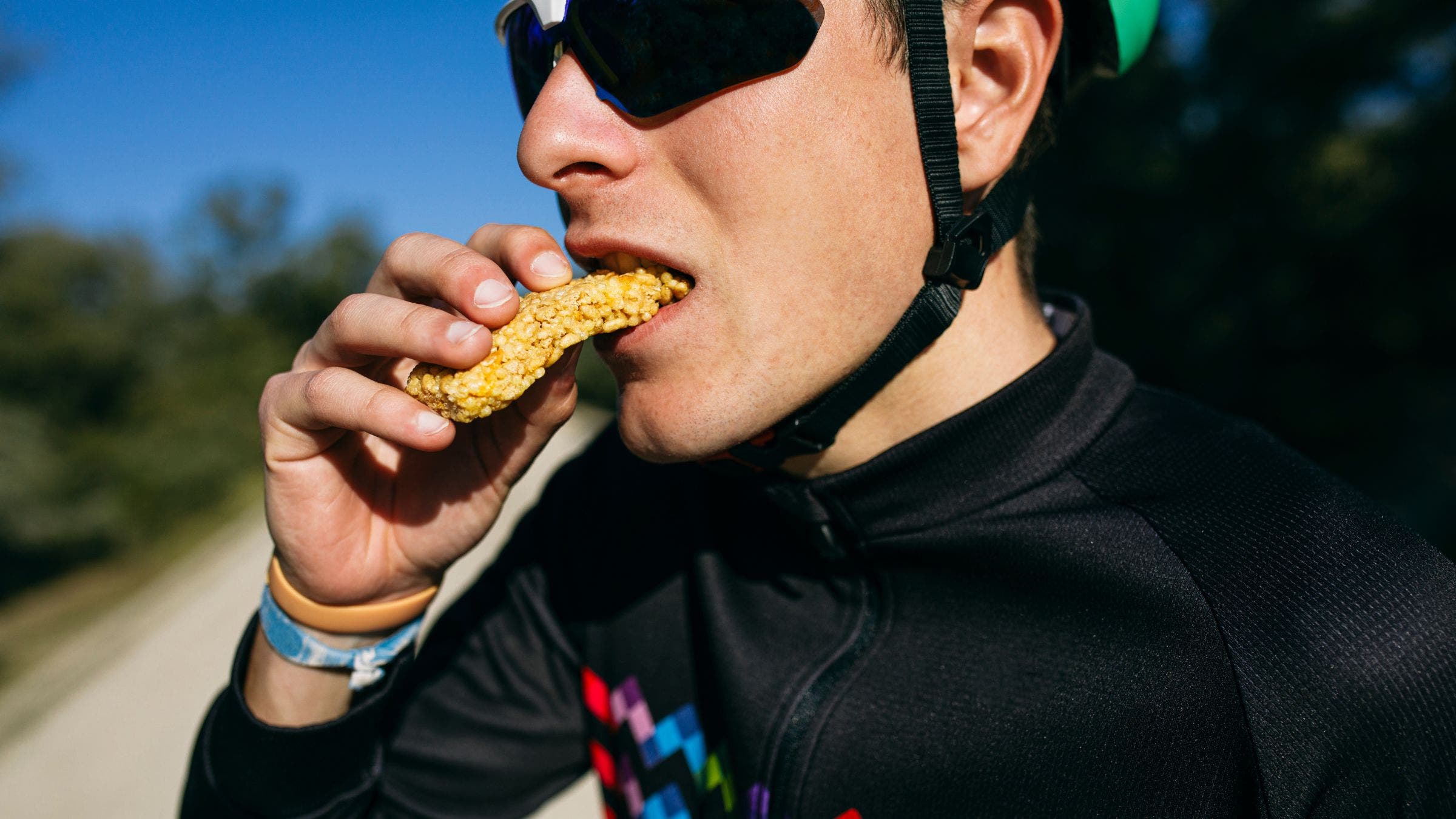
Let’s assume both of the example athletes described above (Week 0) have progressed through the first 5 weeks, with an improved appreciation for daily nutrition required to achieve weight loss and improved health. They are now beginning to have longer and more intense workouts in their training program. As such, it is important to identify how to fuel accordingly. Each week, the athelte should first review the entire week of training and determine if training volume has increased or decreased. Them, review the intensity and duration each day’s workout(s). This is helpful in determining your big-picture nutritional needs as it pertains to what to eat before, during, and after a workout.
What to eat before a workout
Below, is an example of how the Fuelin program considers pre-workout meals. There are several other compounding factors that influence the choice of meal, yet as a starting point, it is a very good one. The length or intensity of your workout will influence what you eat (or don’t) eat before a session.
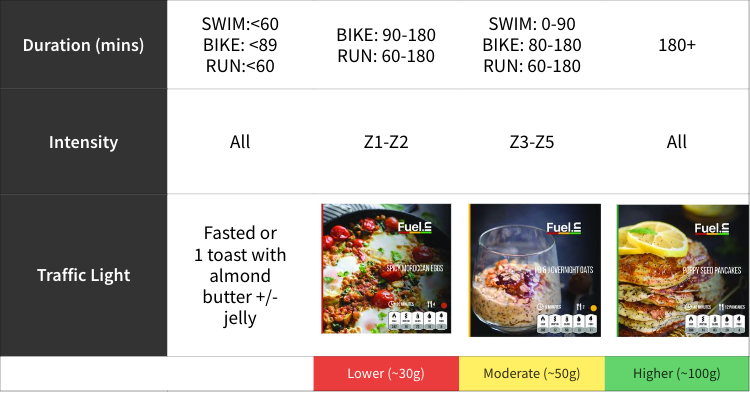
For more advice on pre-workout fueling, the following resources may be helpful:
- Triathlete’s Complete Guide to Nutrition and Fueling
- Top Off Your Tank With These Pre-Workout Snacks
- The Real Scoop on Pre-Workout Supplements for Triathletes
- The Pros and Cons of Fasted Workouts
What to eat during a workout
When it comes to considering in-session fueling, the two most important factors are the intensity and the duration. Both are equally important in determining your need for intra-session fueling. In general, any session that is race pace or above could theoretically be fueled with carbohydrates. The caveat to this is session duration. If your bike session is under 80 minutes and your run under 70 minutes then you can certainly consider not consuming any exogenous fuel during the session. Another consideration to duration is specific to triathletes – the brick. The total duration of the two sessions combined should be considered when contemplating in-session fueling. If longer duration sessions do not exist, then it is recommended to practice race fueling within these shorter sessions.
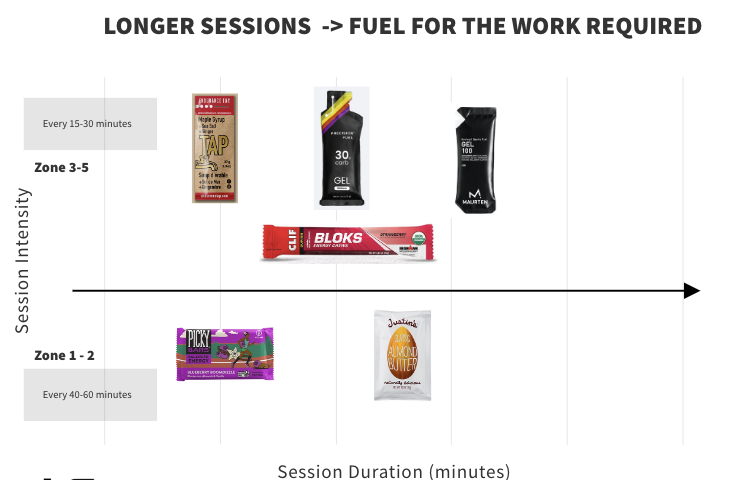
There are a variety of sports nutrition products available to meet the needs and taste preferences of every athlete. To find something that works for you, consider the products in these sport nutrition roundups:
- How to Choose the Best Sports Drink for Triathlon
- We Taste-Tested 19 of the Best (And Weirdest) Drinks, Gels, and Chews
- We Put 23 Electrolyte Drinks to a Taste Test. These Were Our Favorites
- Yes, You Can Make Your Own Sports Drink
What to eat after a workout
The final component of your daily nutrition intake is that of post-session fueling. There are certainly many ways of approaching this, and certainly many recommendations relating to specific post-session fueling. The following is related specifically to carbohydrate amounts following training, and specific to either body composition or performance as an overarching goal.
In terms of protein and fat specific quantities for post-session fueling, for me, the simplest way is to divide your total protein and fat intake by the total number of meals for the day and consume that amount in every meal. This will usually equate to at least 30 grams of protein and 15-20 grams of fat, depending on your body size and number of meals and snacks per day. Do not get too hung up on being perfect with the grams – rather, aim to be consistent with portion-controlled pulses of food throughout the day.
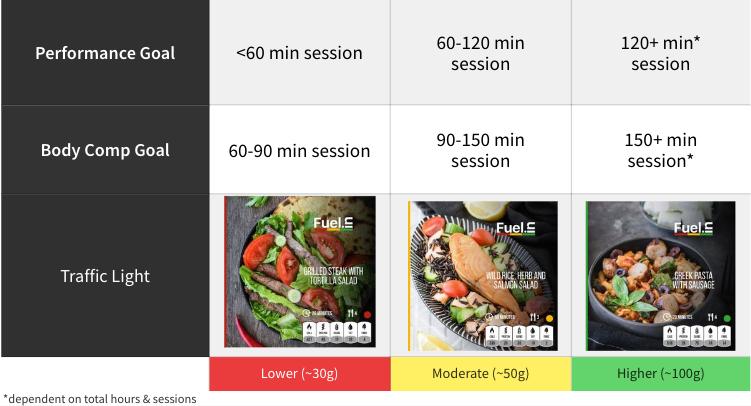
Throughout weeks 5-8, it is recommended to practice race fueling and your hydration strategy. There are several reasons for this, including gaining an understanding of palatability of products, total carbohydrate capacity, the practical aspect of carrying everything on the bike and the run along with the range of fluids and electrolytes required to manage your dehydration appropriately. Part of this is training the gut to be able to cope with higher volumes of carbohydrates and fluids ingested. The science behind training the gut and higher volumes of carbohydrate fueling can be found here. Fluid management and understanding sweat rate will have you well placed as you come into the final weeks of training and work on refining the process.
Weeks 9-12: Refining the race plan
Weeks 5-8 should have allowed the athlete to gain an understanding of their carbohydrate capacity and their sweat rate in race pace scenarios. The knowledge gained through repetition cannot be underestimated. Training gains comes from repetition, and the same can be said for performance nutrition with respect to fueling and hydration.
These final weeks are about you refining the process in order to be prepared for the race and whatever it may throw at you. This means knowing how much carbohydrate you can consume per hour on the bike and the run, knowing what products allow you to hit those numbers, and how you are going to carry them. Will you consume chews, gels, fluids, bars, or a combination of all of them? What is your perfect combination? Only through repetitive training will that become crystal clear. The same goes for fluid management. It’s important to have a clear idea of the target range you are going to be consuming on the bike and run, what you’ll be drinking, how often you’ll drink, and how you’ll replenish your empty bottles during the race.
RELATED: Gain (Don’t Lose) Ground At Your Next Aid Station
You also want to be flexible with both fuel and hydration management. You always want a plan B when something goes wrong, whether it’s losing your bottles on the bike or discovering your special needs bag has gone missing. By practicing and knowing what you are capable of using in these situations, that level of preparedness is increased by a large factor.
Finally, pre-race carbohydrate loading should be practiced to ensure you are comfortable with it and also to know what your pre-race meals will be, from the night before the race to the morning of. Do not leave these details to chance. Your race-day breakfast should be second nature to you by the time the big day rolls around.
When all is said and done, these 12 weeks of focusing on your nutrition should help you to see the complexity involved in performance nutrition, and why it is a good idea to reach out to experts in their own fields to get assistance. As I quite often say: “If triathlete nutrition was easy, everyone would be smashing it!”
RELATED: Registered Dietitian, Nutritionist, Health Coach—What’s The Difference?
Scott Tindal is a nutrition coach, with 20+ years of experience in professional sports. He is the founder of Fuelin, a personalized nutrition program that syncs directly with Training Peaks, Today’s Plan & Final Surge. He sits on the Ironman advisory board as a performance nutrition expert, and holds an MSc in Sports and Exercise Medicine from the Queen Mary University of London. Scott was the head of performance nutrition for Toronto Maple Leafs (NHL) & Oracle Team USA.